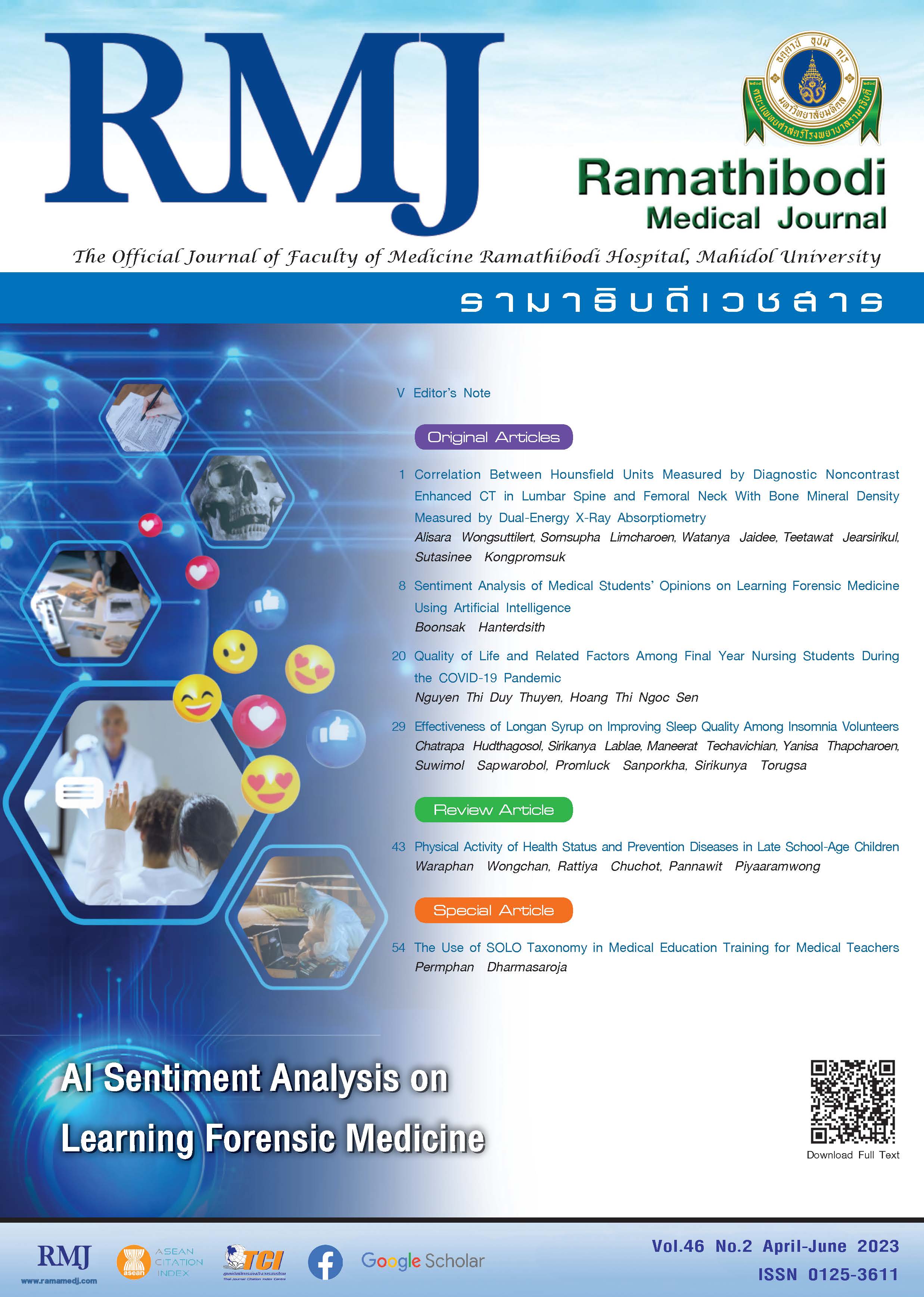The Use of SOLO Taxonomy in Medical Education Training for Medical Teachers
DOI:
https://doi.org/10.33165/rmj.2023.46.2.262412Keywords:
SOLO taxonomy, Medical teacher, Medical education, Faculty developmentAbstract
Medical teachers need training in medical education to improve their teaching skills, keep up with modern teaching methods, and promote student-centered learning. Multiple methods exist for training medical teachers in the area of medical education. The SOLO (Structure of the Observed Learning Outcome) taxonomy can be included in training medical teachers. The SOLO taxonomy has five levels, which is used as a framework for assessing depth of understanding and the complexity of a learner’s response to a question. Here, the author constructed two questions in the field of medical education and provided examples of answers related to each level of understanding in the SOLO taxonomy. A medical educator can employ the SOLO taxonomy to conduct a qualitative analysis of the level of understanding of medical teachers and can use this understanding to design training activities that promote higher levels of thinking and understanding. Additionally, the SOLO taxonomy can be used to improve the effectiveness of training strategies, as well as to provide targeted feedback to medical teachers.
References
Irby DM, Cooke M, O’Brien BC. Calls for reform of medical education by the Carnegie foundation for the advancement of teaching: 1910 and 2010. Acad Med. 2010;85(2):220-227. doi:10.1097/ACM.0b013e3181c88449
Alexandraki I, Baker R, Kern A, Beck Dallaghan GL, Seegmiller J. Faculty development for community preceptors: a narrative review of the literature. J Gen Intern Med. 2023;1-15. doi:10.1007/s11606-023-08026-5
Steinert Y, Naismith L, Mann K. Faculty development initiatives designed to promote leadership in medical education. a BEME systematic review: BEME Guide No. 19. Med Teach. 2012;34(6):483-503. doi:10.3109/0142159X.2012.680937
Ramani S, Leinster S. AMEE Guide No. 34: Teaching in the clinical environment. Med Teach. 2008;30(4):347-364. doi:10.1080/01421590802061613
AMEE. Courses: Essential Skills in Medical Education. Accessed April 17, 2023. https://amee.org/what-is-amee/courses
Svensäter G, Rohlin M. Assessment model blending formative and summative assessments using the SOLO taxonomy. Eur J Dent Educ. 2023;27(1):149-157. doi:10.1111/eje.12787
Martin E, Prosser M, Trigwell K, Ramsden P, Benjamin J. What university teachers teach and how they teach it. Instr Sci. 2000;28:387-412. doi:10.1023/A:1026559912774
Biggs JB, Collis KF. Evaluating the Quality of Learning: The SOLO Taxonomy (Structure of the Observed Learning Outcome). Academic Press; 1982.
Chandrasegaran AL, Treagust DF, Mocerino M. The development of a two-tier multiple-choice diagnostic instrument for evaluating secondary school students’ ability to describe and explain chemical reactions using multiple levels of representation. Chem Educ Res Pract. 2007;8(2):293-307. doi:10.1039/B7RP90006F
Damopolii I, Nunaki JH, Nusantari E, Kandowangko NY. The effectiveness of inquiry-based learning to train students’ thinking skill based on SOLO taxonomy. J Phys: Conf Ser. 2020;1567:042025. doi:10.1088/1742-6596/1567/4/042025
Emmanuel E, Collins D, Carey M. My face, a window to communication: using creative design in learning. Nurse Educ Today. 2010;30(8):720-725. doi:10.1016/j.nedt.2010.01.011
Pandey P, Zimitat C. Medical students’ learning of anatomy: memorisation, understanding and visualisation. Med Educ. 2007;41(1):7-14. doi:10.1111/j.1365-2929.2006.02643.x
Chrismawaty BE, Emilia O, Rahayu GR, Ana ID. Clinical reasoning pattern used in oral health problem solving - a case study in Indonesian undergraduate dental students. BMC Med Educ. 2023;23(1):52. doi:10.1186/s12909-022-03808-7
Canfield PJ, Krockenberger MB. An interactive, student-centered approach, adopting the SOLO taxonomy, for learning to analyze laboratory data in veterinary clinical pathology. J Vet Med Educ. 2002;29(1):56-61. doi:10.3138/jvme.29.1.56
Williams MT, Lluka LJ, Meyer JHF, Chunduri P. SOLO-based task to improve self-evaluation and capacity to integrate concepts in first-year physiology students. Adv Physiol Educ. 2019;43(4):486-494. doi:10.1152/advan.00040.2019
D'Antoni AV, Mtui EP, Loukas M, Tubbs RS, Zipp GP, Dunlosky J. An evidence-based approach to learning clinical anatomy: a guide for medical students, educators, and administrators. Clin Anat. 2019;32(1):156-163. doi:10.1002/ca.23298
Prakash ES, Narayan KA, Sethuraman KR. Student perceptions regarding the usefulness of explicit discussion of “structure of the observed learning outcome” taxonomy. Adv Physiol Educ. 2010;34(3):145-149. doi:10.1152/advan.00026.2010
Biggs JB, Tang C. Teaching for Quality Learning at University. McGraw-Hill Education (UK); 2011.
Durak HY, Uslu NA. Investigating the effects of SOLO taxonomy with reflective practice on university students’ meta-cognitive strategies, problem-solving, cognitive flexibility, spatial anxiety: an embedded mixed-method study on 3D game development. Interact Learn Environ. 2022:1-23. doi:10.1080/10494820.2022.2067187
Pinto Zipp G, Maher C, Donnelly E, Fritz B, Snowdon L. Academicians and neurologic physical therapy residents partner to expand clinical reflection using the SOLO taxonomy: a novel approach. J Allied Health. 2016;45(2):e15-e20.
Mindayani N, Hadi W, Ambarita B. The development of SOLO taxonomy based assessment tool on text of observation reports of X grade students of senior high school 1 NA. IX-X. BirLE Journal. 2019;2(4):371-381. doi:10.33258/birle.v2i4.527
Leung CF. Assessment for learning: using SOLO taxonomy to measure design performance of design & technology students. Int J Technol Des Educ. 2000;10(2):149-161. doi:10.1023/A:1008937007674
Berman J, Smyth R. Conceptual frameworks in the doctoral research process: a pedagogical model. Innov Educ Teach Int. 2015;52(2):125-136. doi:10.1080/14703297.2013.809011
Clarke D, Hollingsworth H. Elaborating a model of teacher professional growth. Teach Teach Educ. 2002;18(8):947-967. doi:10.1016/S0742-051X(02)00053-7
Biggs JB, Tang C. Teaching for Quality Learning at University. 3rd ed. McGraw Hill Education & Open University Press; 2007.
Stotsky A. Modified SOLO Taxonomy Model for Constructive Alignment in Automatic Control & Signal Processing Education. August 10, 2017. Accessed April 17, 2023. https://publications.lib.chalmers.se/records/fulltext/249992/local_249992.pdf
Weay AL, Masood M, Abdullah SH. Systematic review of revised bloom taxonomy, SOLO taxonomy and Webb’s Depth of Knowledge (DOK) in assessing students' historical understanding in learning history. Malaysian Journal of Higher Order Thinking Skills in Education. 2016;3:1-27.
Koskinen H. Evaluation of the level of difficulty of patient cases for veterinary problem-solving examination: a preliminary comparison of three taxonomies of learning. J Vet Med Educ. 2007;34(2):106-111. doi:10.3138/jvme.34.2.106
Parmar D, Lin L, Dsouza N, et al. How immersion and self-avatars in VR affect learning programming and computational thinking in middle school education. IEEE Trans Vis Comput Graph. 2022;PP:10.1109/TVCG.2022.3169426. doi:10.1109/TVCG.2022.3169426
Downloads
Published
How to Cite
Issue
Section
License
Copyright (c) 2023 Ramathibodi Medical Journal

This work is licensed under a Creative Commons Attribution-NonCommercial-NoDerivatives 4.0 International License.

















